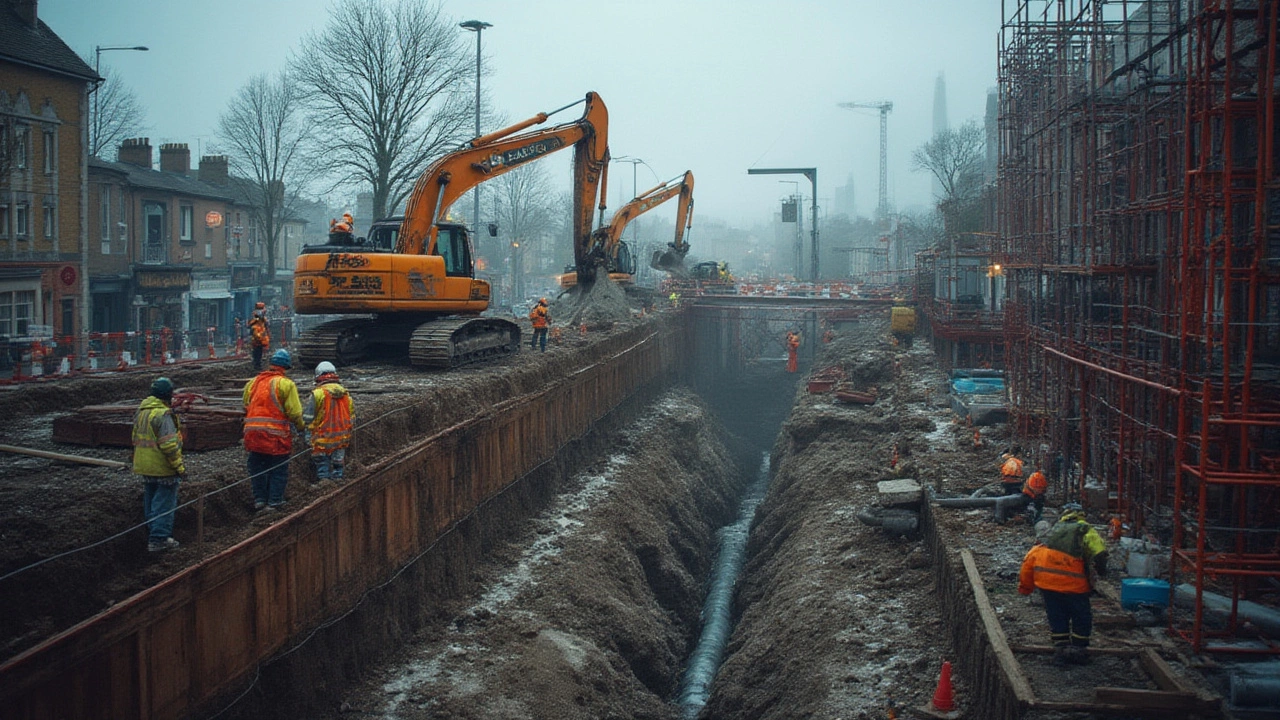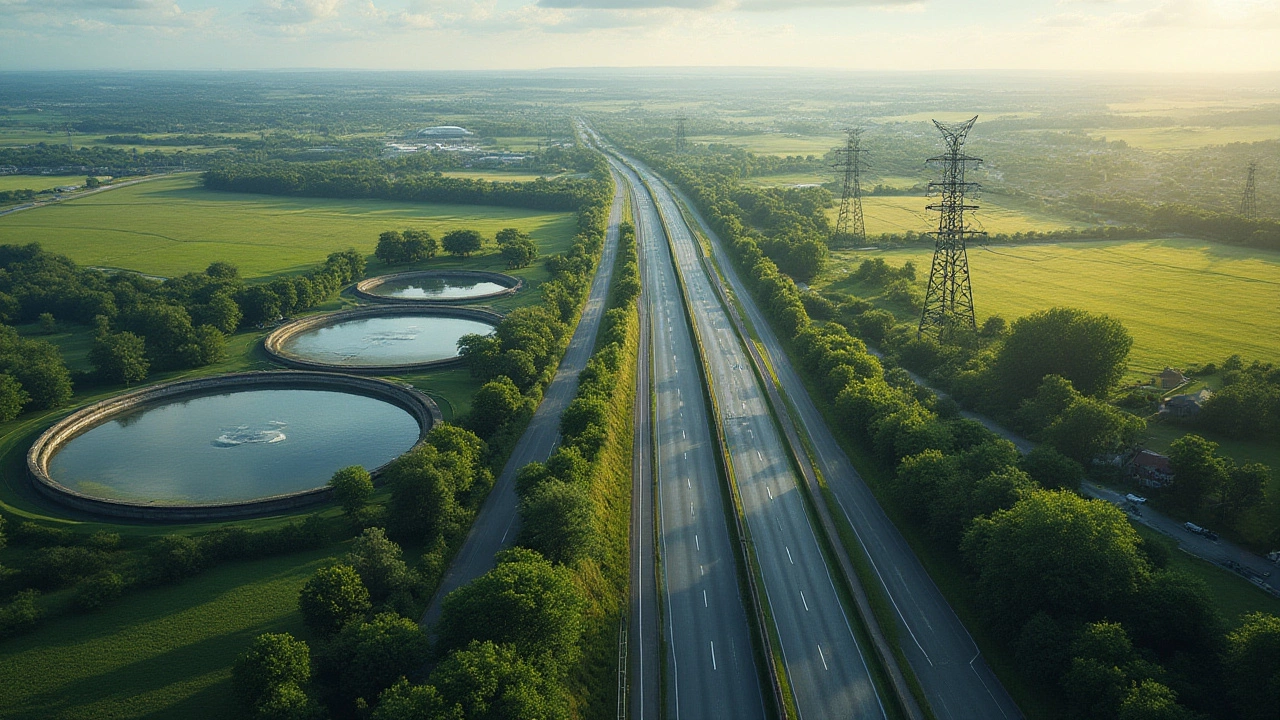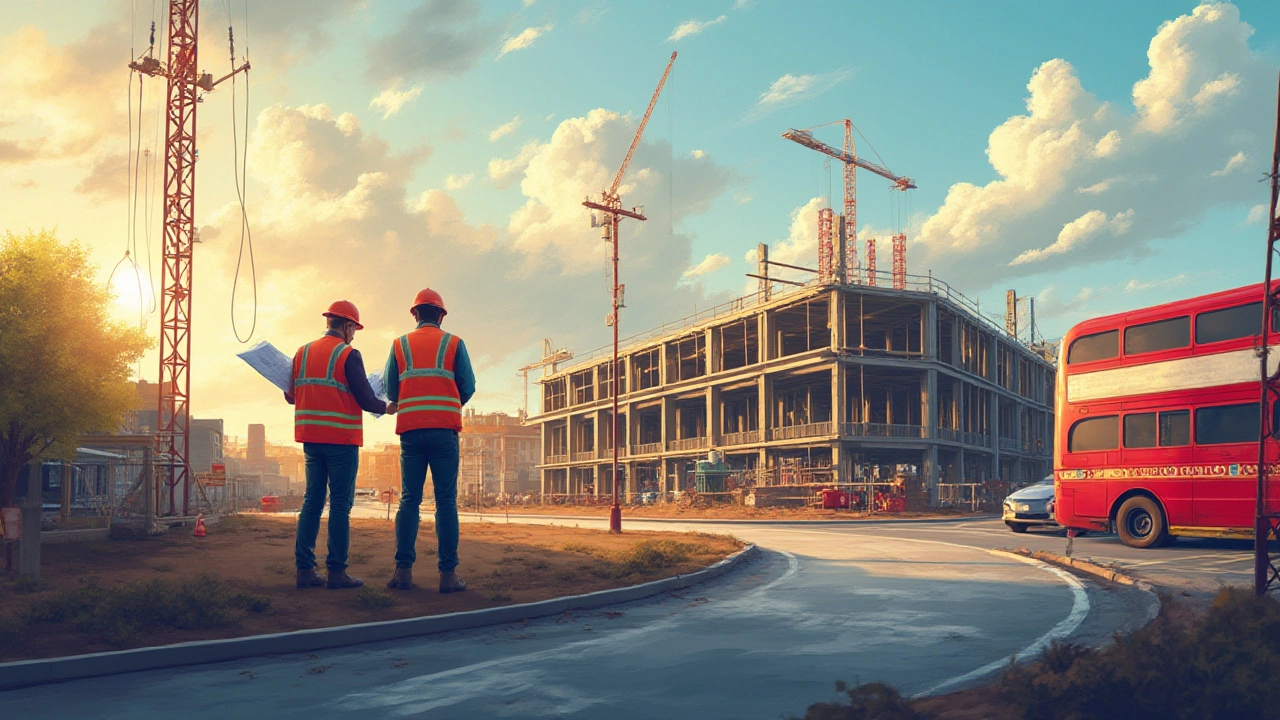Civil Construction Explained: Key Components, Services, and Industry Secrets
 Jul, 31 2025
Jul, 31 2025
Think about the last trip you took across a big highway, the last time you drank clean water from your kitchen tap, or even the sidewalk you walked while heading to the coffee shop. None of these things just appeared. Civil construction is what makes all this possible. This field sits right at the heart of society, responsible for the things you don't usually notice—unless they're not there or not working. But what exactly falls under civil construction? There's a lot more going on behind those orange cones than most people realize. From the smallest storm drain to the tallest water tower, this industry is massive, meticulous, and honestly, a little bit fascinating.
What Is Civil Construction?
People toss around the term "civil construction" pretty loosely, and unless you're in the business or an engineer, it can sound vague. At its core, civil construction is all about the building and maintenance of infrastructure. Think roads, bridges, tunnels, airports, water pipelines, treatment plants, railways, and so much more. These projects don’t just pop up—they’re meticulously planned, often span years, and involve entire squads of engineers, architects, contractors, and specialist trades. And it's not just about placing concrete and steel. There’s surveying land, securing permits, estimating costs, sticking to safety codes, managing teams, and solving unexpected headaches (bad weather, tricky soil, supply chain mess-ups—you name it).
Want some perspective? Globally, civil construction eats up more than half of the total money spent in the wider construction world. According to Statista’s 2024 report, infrastructure spending hit nearly $4.6 trillion, outpacing all other construction sectors. Cities can’t grow, businesses won’t expand, and communities won’t function without this backbone. It’s kinda wild when you realize just how many layers there are—right from laying foundations and pouring roadways, to water treatment, stormwater management, and even landscaping around public parks.
What grabs most people by surprise: civil construction is as much about planning and maintenance as the physical building. A completed highway or dam isn’t the finish line; those assets need constant inspections, upgrades, and repairs to keep working safely. And with climate extremes becoming the new normal, the industry now faces huge pressure to build things not only stronger and smarter but greener and more resilient.
Main Types of Civil Construction Projects
You’d be hard-pressed to name even a handful of big public works that don’t tie back to civil construction. If you walk around your city or drive cross-country, practically everything you use is shaped by this industry. Here’s a breakdown of the most common types you’ll find snapping up city budgets or filling out government contracts:
- Transportation Infrastructure: Roads, highways, freeways, railways, airports, bridges, tunnels, and subway lines. Think about all those traffic cones you see—each means a project tying neighborhoods, cities, or even countries together.
- Water Infrastructure: Dams, reservoirs, water pipelines, waste treatment plants, and sewer systems. Your morning shower? Civil construction lays all the pipes and plants to make it happen.
- Energy Infrastructure: Power plants, transmission lines, wind farms, and solar parks. Behind every lamp post and charging station is some heavy-duty civil work.
- Public Facilities: Schools, hospitals, government buildings, stadiums, and public parks. There’s always a civil angle—grading the land, running utilities, laying parking lots, and handling stormwater flow.
- Environmental and Flood Control: Levees, sea walls, drainage channels, and wetlands restoration. These projects aren’t always flashy but stop disasters like floods and coastal erosion.
Here’s a quick table that details common project types and their typical timelines:
| Project Type | Project Scale | Typical Duration |
|---|---|---|
| Highway Expansion | State/National | 2-8 years |
| Bridges & Tunnels | Regional | 1-5 years |
| Water Treatment Facility | City/District | 1-4 years |
| Stadium Construction | Community/City | 18-36 months |
| Flood Barriers | Coastal/Urban | 2-5 years |
One thing that stands out: every project, no matter the size, is a complex puzzle of budgeting, engineering, weather, and logistics. The stakes? Public safety, millions (sometimes billions) of dollars, and deadlines everybody feels—especially commuters who hit detours daily.

Essential Phases in Civil Construction
So, how does a giant project like a bridge or a wastewater plant even get off the ground? Each job follows a strict set of phases, and skipping any step could end in disaster. Here’s what usually goes down:
- Planning & Feasibility: Teams kick off with site surveys, environmental impact studies, and number crunching. This is when stakeholders decide if the project makes sense, both technically and economically. They also hold public meetings to get input and smooth over concerns.
- Design: Civil engineers and architects draw up plans and sort every detail—how deep the foundations go, what materials to use, and where every pipe will run. These blueprints are checked and double-checked for safety.
- Pre-Construction: Permits are chased down, contractors are hired, supplies ordered, and detailed schedules built. This is also when teams figure out how to keep the public safe while work goes on (think of all those warning signs and traffic redirects).
- Construction: Crews roll out with bulldozers, cranes, and tools to turn those blueprints into the real thing. There’s a lot of testing as each piece goes into place, plus inspectors checking that everything meets building codes.
- Inspection & Handover: Before anyone is allowed to use the project—a new highway, a massive dam, whatever—it gets one last inspection for safety and quality. Any tweak or repair is done at this point.
- Maintenance: The job’s not over. Bridges need repainting to avoid rust. Roads need patching as weather takes its toll. Utilities get regular checks for leaks or wear and tear, because a single failure can shut down an entire neighborhood.
This whole system is intensive, detailed, and often tied up in city meetings, legal hearings, and red tape. The upside? It works. That bridge you speed over during rush hour was built, inspected, and maintained thanks to a team that didn’t cut corners. And yes, delays and budget overruns are a thing — but nobody wants their morning commute turning into a swim because someone skimped on the waterproofing.
Key Services and Specialties in Civil Construction
There’s no "one size fits all" civil construction crew. A big city tunnel project might have hundreds of contractors, each handling a unique slice of the work. Here’s a quick peek at the nuts and bolts services that keep jobs moving:
- Site surveying and land grading
- Foundation excavations and shoring
- Concrete pouring and structural framing
- Earthworks (cutting, filling, dredging)
- Paving (asphalt, concrete, specialty surfaces)
- Pile driving and deep foundations
- Underground utility installation (water, sewer, electric, gas)
- Stormwater and floodwater control systems
- Steel and rebar fabrication
- Specialized demolition
- Environmental remediation
Many firms now offer design-build services. What’s that? A single company does both the planning (blueprints, permits) and the actual building, cutting out a ton of back-and-forth and reducing headaches. Others stick to their lane—maybe all they do is roads, or maybe just bridges. The technology is always evolving: GPS-guided machinery, drones for land mapping, and 3D modeling are bringing new speed and precision to old-school work. It’s not just about muscle. Today’s civil construction work is as much tech-driven as it is hands-on.
Odd fact: the world’s biggest tunnel boring machine is as long as a football field and can chew through rock at nearly 3 inches per minute. These machines don’t just dig; they set down tunnel walls as they go, slicing years off old construction timelines.

Trends and Innovations Shaping Civil Construction
The field isn’t immune to change. Right now, there are a few big trends shaping how—and what—civil construction delivers:
- Green Infrastructure: Projects now favor renewable materials, rainwater harvesting, and designs that help cities handle flooding and heat waves. There’s a push for “green concrete” mixes, recycled steel, and solar-powered street lighting.
- Smart Cities: New roads and bridges pack sensors to track traffic, air quality, and even pothole development in real-time. Look at cities like Singapore and Barcelona—they’ve built massive networks to monitor utilities and streamline repairs before the public ever notices a problem.
- Modular Construction: Instead of building everything on-site, more teams now use “pre-fab” pieces built offsite in controlled environments. Those pieces are then shipped and installed, slashing project times and keeping quality high—even when the weather goes bananas.
- AI and Robotics: Drones inspect hard-to-reach bridges. AI helps spot weak points in pavements or suspension. Robots now lay bricks, tie rebar, or beam back data on structural movement.
And there’s a human side—workforce shortages are driving wages up and pulling in more apprentices. Safety tech is smarter: wearable sensors keep tabs on worker fatigue and real-time site conditions, making an already dangerous field a bit safer every year.
Table below shows a few examples of tech adoption rates as of the latest 2025 construction surveys:
| Technology | Adoption (%) |
|---|---|
| Drone Surveying | 60% |
| BIM (3D Modeling) | 72% |
| Smart Sensors | 38% |
| AI-Powered Maintenance | 22% |
This isn’t just "nice to have" stuff—it means bridges and tunnels can watch themselves, flagging problems before they turn into disasters. The next time you cross a shiny new overpass or drive through yet another round of roadworks, remember: there’s a sprawling web of people, machines, and plans keeping it all together, adapting faster than most of us realize.
